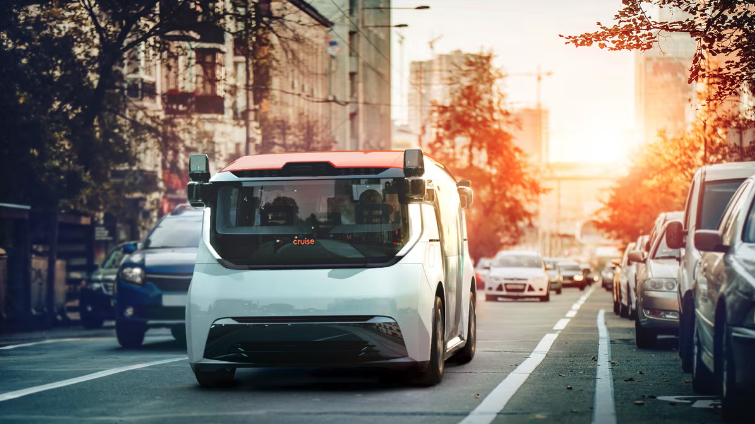Cruise -
Internal Ops Origin Readiness
Hi! Thanks for checking out this project :)
To comply with NDA, certain parts of the project were edited or removed.
Context
Cruise is a motor vehicle manufacturing company that designs and builds world leading autonomous vehicles. The company has been testing specially built self-driving EVs in various cities in the U.S.
In 2020, Cruise unveiled their development of Origin, a minivan-looking electric bus. As Cruise increased production of their new development in 2023, they aimed to gradually replace the Bolt with Origin.
My project focused on understanding internal tooling teams’ readiness for the transition to Origin.
Problem Statement
As business decisions regarding the transitions evolve, we knew very little about how ready internal tooling teams are with the upcoming changes.
Research Questions
Q1: How do new features of the Origin affect the processes & needs in internal tooling?
Literature review & field studies
Q2: Who may be affected by these new features of Origin?
Semi-structured interviews with internal tooling operators
Q3: How ready are internal tooling teams with the transition to Origin?
Semi-structured interviews with Subject Matter Experts (SMEs)
Research Process
-
Problem Framing
Worked collaboratively to understand the problem and why it is important
Literature Review
Reviewed existing research regarding Bolt and Origin
-
Research Plan
Field research guide and interview script
Recruitment
Determined target participants and availability
Logistics
Arranged field visits at both Bolt and Origin launching/production facilities, scheduled interviews
-
Field studies with operators across teams
Observed and interviewed current operations’ workflows
Noted potential differences between Bolt and Origin
Semi-structured interviews with subject matter experts (SMEs) across teams
Understood the incompatibilities between their current processes with anticipated future processes given existing knowledge
Measured the severity of these incompatibilities
-
Findings Synthesis
Identified known findings and new knowledge
Transformed findings into meaningful and actionable insights
Quantified risks for insights
Recommendations
Generated “how might we” questions to inspire future research
Selected Key Findings
Q1: How do the new features of the Origin may affect the processes & needs in internal tooling?
Finding 1:
Lack of steering wheel creates costly and inefficient risks for in-garage navigation
Current Process
Origin’s in garage navigation relies on an external vehicle controller (XVC) as there is no driver’s seat, which
Requires two ops to operate
One operator
One looker due to limited camera view
E.g., moving an Origin from egress spot to parking spot (~50ft) requires 2 ops to manually plug in XVC and operate
Risks
XVC is costly, risky, and inefficient for in garage navigation
XVC is expensive
Limited camera views on XVC increases risk for accidents and potentially poor navigation
Requiring two ops to use XVC is inefficient
“I can’t see very well because XVC’s screen is small and the windows on Origin are pretty small too”
How might we…
Develop more efficient, cost-effective, and safer tools for in garage navigation?
Risks
More capacity will likely make communication with passengers more chaotic
Potentially decreasing communication quality
“I had three passengers, and and all I can hear is the other two singing to radio, it’s hard to hear the primary account holder”
“Someone jumped into a call, and all I could hear is their friends screaming”
How might we…
Ensure high quality communications between CSS and passengers by reducing distraction?
Finding 2:
Having more passengers creates potential complications for customer service
Current Process
Origin will have increased capacity and can seat up to 6 passengers
It is likely that customer service will speak with 6 passengers at once during communications
Q2: Who may be affected by these new features of Origin?
Finding 1:
AV Operators
Not having a steering wheel/driver’s seat creates significant challenges and risks
Finding 2
Onsite Assistance
Not having a steering wheel/driver’s seat means that Origins will rely on towing if failed in field, which may cause increased efforts into monitoring towing status
Finding 3
Customer support
Greater capacity in the Origin opens possibilities for more chaotic and complicated communications between customer support and other parties
Q3: How ready are internal tooling teams with the transition to Origin?
Finding:
Operators are not familiar with Origin and uncertain about how to prepare for transitioning to Origin
10 out of 11 ops across teams mentioned that they “don’t really know about the features
“All I know is that there is no steering wheel, but I don’t know how much that will affect our workflows”
“They haven’t really told us anything about the Origin and I don’t know what will change”
“I don’t really know about the features on the Origin”
Risk
Operations’ increased confusion and uncertainty
Lack of information and preparation
How might we…
Ensure that teams are informed about Origin and timeline?
Help internal tooling/operations adequately prepare for Origin as we transition?
The Impact
This Research
Uncovered critical roadblocks for achieving company’s business goals
Identified areas for improvement to minimize risks and costs, as well as to improve efficiency and reliability
Personal reflections
I learned to
work with stakeholders to define research scope
speak stakeholder languages with different teams
think strategically about navigating research to align with business decisions

